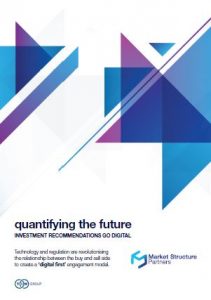Executive Summary

This research explores how technology and regulation are converging to revolutionise broker (sell-side) and investment management (buy-side) relationships:
- Technology and regulation are revolutionising the relationship between the buy and sell-sides, creating a ‘digitally led’ engagement model which will radically alter both the consumption and provision of investment recommendations.
- Active Investment Management is under pressure and has been losing out to technology driven investment styles. The initial beneficiary of this shift was passive management but quantitative management is growing. Active managers are taking notice and a new style of quasi-active models is emerging, requiring entirely new tools and techniques and expanded data sets. In our global research based on interviews with fund managers, evenly split between quantitative and active managers, 94% of respondents thought that funds using quantitative techniques would continue to increase in popularity.
- This creates different demands on the sell-side and quantitative managers are leading the way in redefining the service requirements. The industry is moving away from an emphasis on individual research recommendations towards cumulative data streams from a diverse set of multiple sources. This provides a faster, continuous view of market sentiment. 61% of those interviewed are already reacting to aggregate market sentiment rather than individual research recommendations. Whilst the responding firms may continue to process research recommendations, they are increasingly placing more weight on short-term ideas and other broker signals than on research alone.
- The breadth of information being sought is not only generated by multiple contributors from chosen sell-side firms but also from new data sets generated by different brokers and individual experts. 69% of respondents thought that the best quality recommendations in small and mid-cap now come from local and regional specialists. Some cited new sets of broker-compiled data that they pay for, for example summaries of short positions or agricultural data feeds.
- Whilst brokers search for new ways to engage with their clients on a digital basis, funds are now incorporating strategies based on increasingly diverse sources of alternative data. Some of this is financial such as earnings persistence and company information but it also includes data generated, for example, by satellite imagery, social media and records of credit card transactions. Our research revealed 56% of those interviewed are now paying fees for other third party data sets.
- As the amount of available data increases, the ability of humans to process it is declining and the sell-side is finding it more difficult to be heard. More than half the interviewees now delete or ignore over 50% of the emails and phone calls they receive from their brokers and 44% of those interviewed already have automated processes in place to manage incoming information from brokers.
- The old style relationship based on written research and conversations between buy and sell-side is therefore unsustainable. While the majority of firms interviewed still incorporate research recommendations into their investment process there is a mismatch between what they consume and what they value. 66% of the firms interviewed valued broker research either to a small degree or not at all. As fund managers allocate budget to increasing numbers of data sets, they will be forced to be more discerning about the data they take, the suppliers they rely on and the evaluation metrics they use. Technology and economics may help but changes in regulation will accelerate these new requirements.
- In Europe, the Market Abuse Regulation (MAR) and the Markets in Financial Instruments Directive (MiFID II) are transforming the way investment recommendations are recorded, evaluated and paid for. This will have global ramifications. Although 43% of respondents are based outside Europe, only 31% believe they are out of scope of MiFID II and 56% plan to change their current processes ahead of it. 77% expect to put automated processes in place to manage and measure broker contributions in the future.
- Sell-side firms must recognize that, while demand for access to investment recommendations remains strong, the delivery and consumption of these recommendations is undergoing radical transformation. There are clear opportunities for firms that embrace a digital model. Many quantitative funds have been underserviced by the bigger banks but technology is helping them to engage easily with local and specialist firms who are creating new data products to monetize. Some funds may not be big enough to access or normalize all the data they would like and brokers may be able to partner with other data originators or delivery mechanisms to help their clients. Those who wish to remain providers of research must recognize the need to make their products more interactive and change their product economics. Most of all this requires a change of culture and discipline that needs strong leadership from the top of the organization.
Read the Report
To read the full report, please visit the TIM website.

